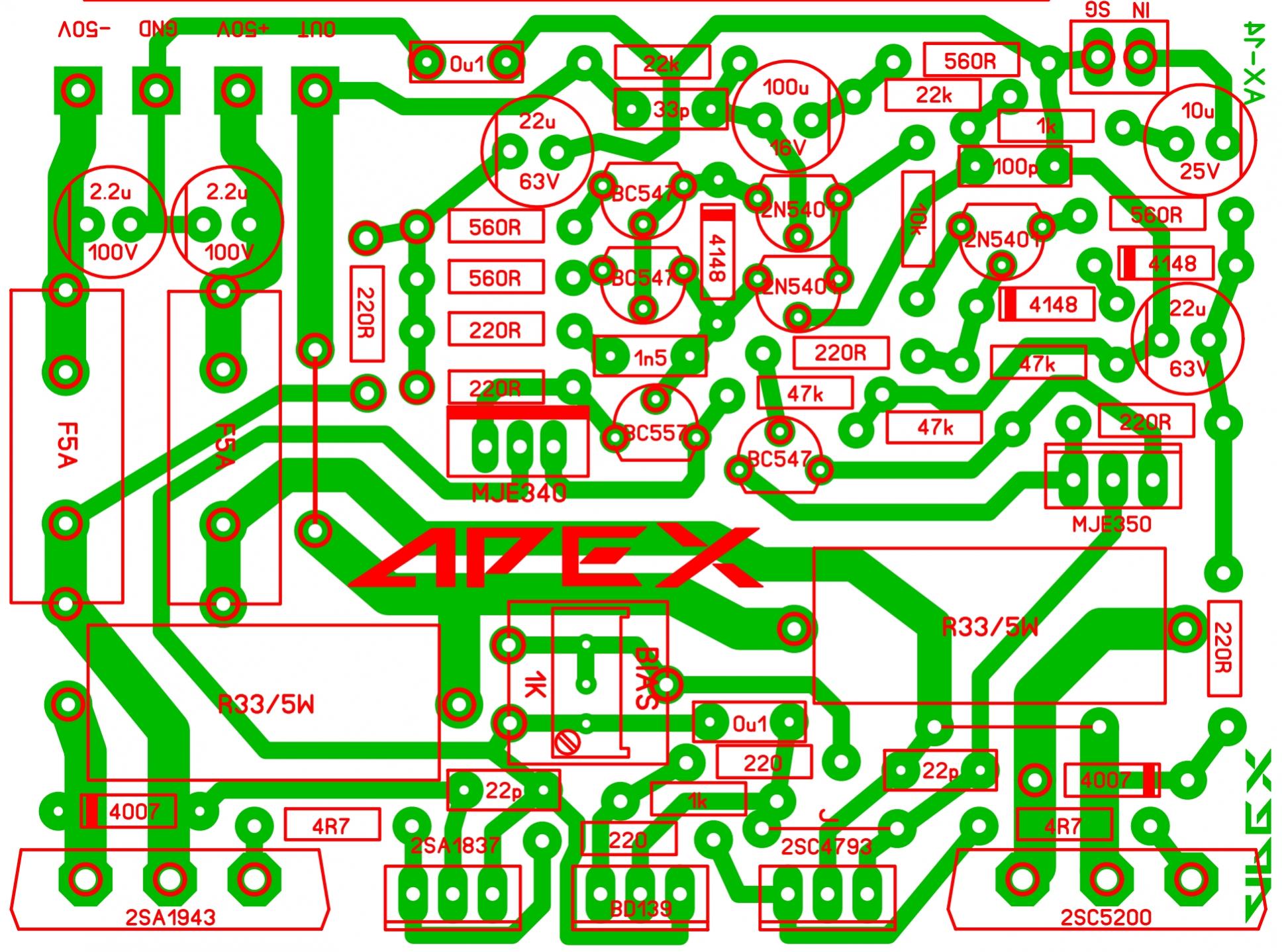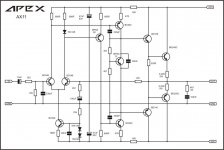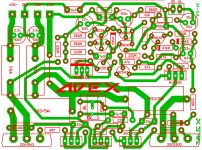Nice Hicoco!Work perfectly and Ready to be add to my new A40 Project
Beautiful and compact!😎
first -AX11 3XL: YouTube
latest files wich I would not change anymore,changing more would mean re-drawing most of it. an amplifier works very well,it has clean sound mostly at high and middle tones. it workes at relatively low power in my house for a few days now without any heatsink,only this peace of aluminium,I-profile. even so,bias is standing still,and simetry is about 20mV without any matching. i used MJE340-350 as predrivers with 220pF compensations,and 2SA1837/2SC4793 as driver transistors. also,i used 4k7 trim.pot. instead 3k3 in bias circuite,to adjust bias as i like. it is supposed to be changed later for normal resistor with same resistance as trim.pot. is in a moment when bias is set as wanted.
feel free to use large heatsinks at predrivers,they make pretty much heat. as they are right now they are at about 50 degrees Celsious but much of that heat is transfered from the back-from output transistors wich are now at about 60 degrees Celsious-as it is.
Attachments
Last edited:
For those that have heard the AX14 and the FH9, in your opinion, which one sounds more musical? For music purposes that is. Im going to build either one, was just hoping for a bit of a guide to choose. If parts be a concern, the FH9 would be a better option for me as it doesnt use the 2SC5200 and the 2SA1943's which I have a problem getting
Sorry, I have not heard FH9 but I'm pretty sure it is well received and didn't have any faults pointed out by builders. You should most definitely build it.
I can however give you a comparison of AX14 to other amps that I have built. This is of course just my opinion. I'm not a professional in audio or electronics and any of these builds could sound and behave differently depending on what combination of components and power arrangements are used. Take this with a grain of salt as I'm also just spending idle time during "lockdown" and have time to write some rambling gibberish...
Tied for 1st: AX14 and PeeCeeBee v4. Both are silent with no music, and very detailed in mids and highs. I would give a very slight edge to PeeCeeBee v4 in bass but a slight advantage to AX14 in upper midrange. Both AX14 and PeeCeeBee v4 have excellent imaging. I could switch between the two and not be able to tell the difference. AX14 is simple to set up. Just a bias adjustment. Set it and forget it (almost). With the tempco transistor mounted directly on an output transistor, the bias is very stable. I does increase with temperature but is steady and predictable.
2nd: VSQC, Dacz board version with IRFP240 and NJW3281G output transistors, +-42 VDC rails. This amp sounds very good everywhere. My only, almost unmentionable, minor negative is the dc offset and bias adjustments need to be "chased around" quite a bit. Meaning they change between cold and warm and are more reactive to the environment and air movement. Nothing extreme or alarming, just not rock stable like experienced with the Honey Badger and AX14. If I had never built these other amps, I would not know the difference.
3rd: VSQC high output. Same as above but using FQA40N25 mosfet and MJL4281AG bjt output transistors with +-52VDC rails. Sounds very good but is missing a tiny amount of upper midrange compared with the standard VSQC.
4th: Honey Badger. Sound is very good. Imaging excellent. Mids are excellent, high end a little harsh. Bass is strong. Bias and offset are super stable. All adjustments respond as they should. I have a hiss in left channel that I have never been able to eliminate. Minor but noticeable. It may be an error on my part or environmental interference. It deserves more troubleshooting on my part.
5th: I group together 2 chip amps, TDA7293 and LM3886. These are both easily implemented and sound surprisingly good. I prefer TDA7293 due to its superior bass output. LM3886 is slightly better in mids and highs but lacks the impact.
Sorry, I have not heard FH9 but I'm pretty sure it is well received and didn't have any faults pointed out by builders. You should most definitely build it.
I can however give you a comparison of AX14 to other amps that I have built. This is of course just my opinion. I'm not a professional in audio or electronics and any of these builds could sound and behave differently depending on what combination of components and power arrangements are used. Take this with a grain of salt as I'm also just spending idle time during "lockdown" and have time to write some rambling gibberish...
Tied for 1st: AX14 and PeeCeeBee v4. Both are silent with no music, and very detailed in mids and highs. I would give a very slight edge to PeeCeeBee v4 in bass but a slight advantage to AX14 in upper midrange. Both AX14 and PeeCeeBee v4 have excellent imaging. I could switch between the two and not be able to tell the difference. AX14 is simple to set up. Just a bias adjustment. Set it and forget it (almost). With the tempco transistor mounted directly on an output transistor, the bias is very stable. I does increase with temperature but is steady and predictable.
2nd: VSQC, Dacz board version with IRFP240 and NJW3281G output transistors, +-42 VDC rails. This amp sounds very good everywhere. My only, almost unmentionable, minor negative is the dc offset and bias adjustments need to be "chased around" quite a bit. Meaning they change between cold and warm and are more reactive to the environment and air movement. Nothing extreme or alarming, just not rock stable like experienced with the Honey Badger and AX14. If I had never built these other amps, I would not know the difference.
3rd: VSQC high output. Same as above but using FQA40N25 mosfet and MJL4281AG bjt output transistors with +-52VDC rails. Sounds very good but is missing a tiny amount of upper midrange compared with the standard VSQC.
4th: Honey Badger. Sound is very good. Imaging excellent. Mids are excellent, high end a little harsh. Bass is strong. Bias and offset are super stable. All adjustments respond as they should. I have a hiss in left channel that I have never been able to eliminate. Minor but noticeable. It may be an error on my part or environmental interference. It deserves more troubleshooting on my part.
5th: I group together 2 chip amps, TDA7293 and LM3886. These are both easily implemented and sound surprisingly good. I prefer TDA7293 due to its superior bass output. LM3886 is slightly better in mids and highs but lacks the impact.
WOW! Thank you for the detailed comparison, exactly what I was looking for. AX14 it is then, PCBway has a special, 5 boards for $22, and that is shipping only, boards are free.
Hi guys. I was going over the list of parts required for my build, and came across what i think is a missing part. As I dont have the schematic, I cant see what it is. This is for the APEX AX14 build, shared by Still4given. Circled in red is a missing component, and I would really appreciate it if someone could maybe help out with the missing part.

Image shared was this one


Image shared was this one
Last edited:
Hi guys. I was going over the list of parts required for my build, and came across what i think is a missing part. As I dont have the schematic, I cant see what it is. This is for the APEX AX14 build, shared by Still4given. Circled in red is a missing component, and I would really appreciate it if someone could maybe help out with the missing part.

Image shared was this one

Sorry, those are just missing circles on the silk screen. If you look at the foil you will see that. I will fix that and repost it.
These may be easier to understand.
Oooh, how stupid could I have been. DAMMIT!
Thank you sir, my stupidity.
No one is calling anyone stupid. Sorry for the poor artwork. I should have cleaned it up before posting it. This is an older Sprint file and I should have inspected it before posting it. Good luck with your build.
Mr. Prasi could I please get your Contact details...
SURESH, INDIA
Hi, I have sent you email.
100W Ultimate Fidelity Amplifier
APEX AX20r,stil under testing. needs a little bit adjustment but it promises:
YouTube
APEX AX20r,stil under testing. needs a little bit adjustment but it promises:
YouTube
No one is calling anyone stupid.
Calling myself stupid, if I just took the time to look at the pcb layout as well, would have seen it
- Home
- Amplifiers
- Solid State
- 100W Ultimate Fidelity Amplifier





